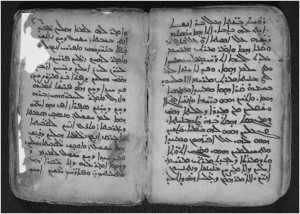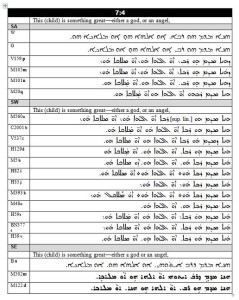Syriac Infancy Gospel of Thomas: Edition in Progress (Part 3)
Between 2012 and 2014 I picked away at the edition while working on other projects. Brent Landau and I had begun the More New Testament Apocrypha project (a series of volumes collecting neglected Christian Apocrypha in new translations) and that took a considerable amount of time to co-ordinate. But I contributed a translation of the Syriac Infancy Thomas to the first volume and this translation integrated for the first time all previously-published manuscripts on the text, including provisional work on the three editions (Sa, Sw, and Sw) I was compiling for the Gorgias volume. We included Syriac Infancy Thomas in the MNTA project because this branch of the tradition, universally believed to be important for establishing the text’s original form, had not appeared in previous Christian Apocrypha collections—typically these compendia contain Greek A, sometimes with Greek B and a portion of the late Latin text.
The MNTA vol. 1 manuscript went to the publisher’s in January 2015, thus allowing me finally to devote most of my energy to the edition. In May and June I compiled a glossary for the three translations, thus ensuring that the texts were translated consistently. It was a very time-consuming project, but very valuable and, of course, will be included in the finished volume.

I took a new look also at the Hill Museum and Manuscript Library, thinking perhaps that other manuscripts of the text had become available. Those of us who do text-critical work on apocryphal texts know that catalogers can be somewhat capricious in describing the contents of manuscripts. Looking simply for the “Infancy Gospel of Thomas” is not enough; you have to look also for Gospel of Thomas, Infancy of Jesus, Gospel of the Infancy, Arabic Infancy Gospel, Life of Mary, and so on. I ran through various search terms and found seven more manuscripts: five for Sw—three in Syriac and two in Garshuni—and two for Sa: one very much like the Vatican MS used by Peeters which combines Arabic Infancy Gospel in Garshuni with Infancy Thomas in Syriac, and one sandwiched between an unidentified infancy text and the Dormition of Mary. This latter manuscript is very important as it is closer to the fifth/sixth-century manuscripts from London and Göttingen than the group of (now-)three manuscripts represented by Peeters’ Vatican MS.

As welcome as this new evidence is for establishing the texts of the two recensions, it means having to make significant adjustments to the critical editions. The way I typically work when editing texts is to draw up a chart of all the manuscript readings. This allows me to see all the readings in one place and arrange the manuscripts into families. For Syriac manuscripts I record all of the diacritical markers, vowel pointing, and punctuation, though only the markers that affect translation end up in the finished edition. Incidentally, Gorgias want me to submit my work camera-ready—i.e., they do not re-typeset the material. This places all of the responsibility for errors on my shoulders but it also means no errors creep into the work during the editing process. Alas, it meant also having to reformat my work for their template. Is it any wonder this edition is taking so long?
So that’s where I am today: entering new manuscript readings into my charts, reworking my Sa and Sw texts to incorporate the additional readings, and hoping to hell I won’t find any more manuscripts before I’m done! I’ll post another update in a few months and let you know how it’s going. Back to work…
